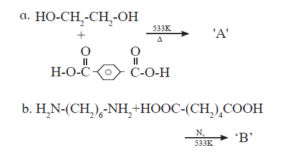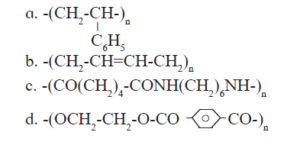15. INTRODUCTION TO POLYMER CHEMISTRY class 12 chemistry textbook solution maharashtra board
1. Choose the correct option from the given alternatives.
i. Nylon fibres are —-
A. Semisynthetic fibres
B. Polyamide fibres
C. Polyester fibres
D. Cellulose fibres
ii. Which of the following is naturally occurring polymer ?
A. Telfon B. Polyethylene
C. PVC D. Protein
iii. Silk is a kind of —- fibre
A. Semisynthetic
B. Synthetic
C. Animal
D. Vegetable
iv. Dacron is another name of —-
A. Nylon 6 B. Orlon
C. Novolac D. Terylene.
v. Which of the following is made up of polyamides ?
A. Dacron B. Rayon
C. Nylon D. Jute
vi. The number of carbon atoms present in the ring of e – caprolactam is
A. Five B. Two
C. Seven D. Six.
vii. Terylene is —-
A. Polyamide fibre
B. Polyester fibre
C. Vegetable fibre
D. Protein fibre
viii. PET is formed by —-
A. Addition B. Condensation
C. Alkylation D. Hydration
ix. Chemically pure cotton is —-
A. Acetate rayon
B. Viscose rayon
C. Cellulose nitrate
D. Cellulose
x. Teflon is chemically inert, due to resence of ………..
A. C-H bond B. C-F bond
C. H- bond D. C=C bond
2. Answer the following in one sentence each.
i. Identify ‘A’ and ‘B’ in the following reaction —-

ii. Complete the following statements
a. Caprolactam is used to prepare——–
b. Novolak is a copolymer of —— — and ———
c. Terylene is ———-polymer of terephthalic acid and ethylene glycol.
d. Benzoyl peroxide used in addtion polymerisation acts as ———-
e. Polyethene consists of polymerised ———-
iii. Draw the flow chart diagram to show classification of polymers based on type of polymerisation.
iv. Write examples of Addition polymers and condensation polymers.
v. Name some chain growth polymers.
vi. Define the terms :
1) Monomer
2) Vulcanisation
3) Synthetic fibres
vii. What type of intermolecular force leads to high density polymer ?
viii. Give one example each of copolymer and homopolymer.
ix. Identify Thermoplastic and Thermosetting Plastics from the following —–
1. PET
2. Urea formaldehyde resin
3. Polythene
4. Phenol formaldehyde
3. Answer the following.
i. Write the names of classes of polymers formed according to intermolecular forces and describe briefly their structural characteristics.
ii. Write reactions of formation of : a. Nylon 6 b. Terylene
iii. Write structure of natural rubber and neoprene rubber along with the name nd structure of thier monomers.
iv. Name the polymer type in which following linkage is present.
v. Write structural formula of the following synthetic rubbers :
a. SBR rubber
b. Buna-N rubber
c. Neoprene rubber
vi. Match the following pairs :
Name of polymer Monomer
1. Teflon a. CH2=CH2
2. PVC b. CF2=CF2
3. Polyester c) CH2=CHCl
4. Polythene d) C6H5OH and HCHO
5. Bakelite e) Dicarboxylic acid
and polyhydoxyglycol
vii. Draw the structures of polymers formed from the following monomers
1. Adipic acid + Hexamethylenediamine
2. e – Aminocaproic acid + Glycine
viii. Name and draw structure of the repeating unit in natural rubber.
ix. Classify the following polymers as natural and synthetic polymers
a. Cellulose b. Polystyrene
c. Terylene d. Starch
e. Protein f. Silicones
g. Orlon (Polyacrylonitrle)
h. Phenol-formedehyde resins
x. What are synthetic resins? Name some natural and synthetic resins.
xi. Distinguish between thermosetting and thermoplastic resins. Write example of both the classes.
xii. Write name and formula of raw material from which bakelite is made.
4. Attempt the following :
i. Identify condensation polymers and addition polymers from the following.

ii. Write the chemical reactions involved in manufacture of Nylon 6,6
iii. Explain vulcanisation of rubber. Which vulcanizing agents are used for the following synthetic rubber.
a. Neoprene b. Buna-N
iv. Write reactions involved in the formation of — 1) Teflon 2) Bakelite
v. What is meant by LDP and HDP? Mention the basic difference between the same with suitable examples.
vi. Write preparation, properties and uses of Teflon.
vii. Classify the following polymers as straight chain, branched chain and cross linked polymers.

5. Answer the following.
i. How is polythene manufactured ? Give their properties and uses.
ii. Is synthetic rubber better than natural rubber ? If so, in what respect?
iii. Write main specialities of Buna-S, Neoprene rubber?
iv. Write the structure of isoprene and the polymer obtained from it.
v. Explain in detail free radical mechanism involved during preparation of addition polymer.
